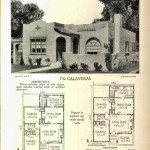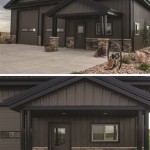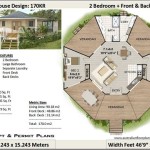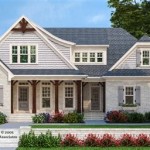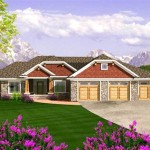1 Floor House Plans 3 Bedroom Free: Design and Considerations
Single-story homes, particularly those featuring a three-bedroom layout, are a consistently popular choice for a diverse range of homeowners. Their accessibility, convenience, and potential for efficient use of space contribute to their enduring appeal. The availability of free 1 floor house plans 3 bedroom options, while often requiring adaptation or professional review, provides a starting point for individuals exploring their housing options. This article explores the key considerations and design elements associated with planning a three-bedroom, single-story house, focusing on aspects relevant to adapting or utilizing freely available floor plans.
When considering free house plans, it's crucial to understand that these resources are typically provided as a starting point and may require significant modification to meet individual needs, local building codes, and site-specific conditions. Factors such as soil type, climate, and zoning regulations all have a direct impact on the feasibility and safety of a building design. Engaging a qualified architect or structural engineer is strongly recommended to ensure that any free plan is properly vetted and adapted for safe and compliant construction.
Key Considerations for Single-Story, Three-Bedroom House Plans
Several key aspects must be carefully considered when evaluating and adapting free 1 floor house plans 3 bedroom. These considerations impact the functionality, comfort, and overall suitability of the dwelling for its intended occupants.
1. Space Optimization and Layout: Successfully designing a three-bedroom house on a single floor requires careful consideration of space optimization. Efficient layouts are essential to maximize usable square footage and minimize wasted space. The relationship between the living areas (living room, dining room, kitchen) and the private areas (bedrooms, bathrooms) is critical. Open-concept designs are often employed to create a sense of spaciousness and improve flow between different zones of the house. Hallways should be minimized to avoid unnecessary space consumption. Thoughtful placement of doors and windows can also contribute to space efficiency and natural light penetration. Furthermore, the orientation of the house on the lot can impact natural light, ventilation, and energy efficiency. South-facing windows, for example, can provide passive solar heating in cooler climates.
The arrangement of bedrooms is also important. Considerations include the size of each bedroom, their proximity to each other and to bathrooms, and the provision of adequate closet space. A master bedroom with an attached bathroom (ensuite) is a common feature in modern house plans. In contrast, the other two bedrooms may share a bathroom. Careful consideration should be given to the placement of the shared bathroom to ensure easy access from both bedrooms and the common living areas. Storage space throughout the house, beyond bedroom closets, is another critical aspect. This includes areas for linen, cleaning supplies, seasonal items, and potentially a pantry in the kitchen.
2. Accessibility and Aging in Place: Single-story homes offer inherent advantages in terms of accessibility. The absence of stairs makes them suitable for individuals with mobility challenges and for those planning to age in place. When adapting a free floor plan, it is important to consider incorporating features that enhance accessibility and support independent living. This may include wider doorways and hallways to accommodate wheelchairs or walkers, grab bars in bathrooms, lever-style door handles, and roll-under sinks. Additionally, ensuring adequate lighting throughout the house can improve safety and visibility for individuals with vision impairments. The design should also consider the potential need for future modifications, such as the installation of a ramp at the entrance. A zero-step entry can significantly improve accessibility for individuals with mobility issues. Also, kitchens and bathrooms need to be designed to facilitate the use of assistive devices in the future.
The principles of Universal Design should be considered throughout the planning process. Universal Design aims to create spaces that are usable by all people, to the greatest extent possible, without the need for adaptation or specialized design. This includes features such as adjustable-height countertops, easy-to-reach outlets and switches, and clear sightlines. Paying attention to these details can make a home more comfortable and functional for people of all ages and abilities. Implementing these elements early in the design process can be more cost-effective than retrofitting later.
3. Energy Efficiency and Sustainability: Energy efficiency is an increasingly important consideration in modern home design. A well-designed single-story house can be highly energy efficient, reducing utility costs and minimizing environmental impact. When evaluating free 1 floor house plans 3 bedroom, attention should be paid to features that promote energy conservation. This includes the orientation of the house to maximize solar gain in winter and minimize it in summer, the proper insulation of walls, ceilings, and floors, and the use of energy-efficient windows and doors. The selection of appropriate building materials can also significantly impact energy performance. Materials with high thermal mass can help regulate indoor temperatures, reducing the need for heating and cooling.
The design should also consider the integration of renewable energy systems, such as solar panels. The roof of a single-story house provides ample surface area for solar panel installation, which can significantly reduce reliance on grid electricity. Water conservation is another important aspect of sustainable design. Installing low-flow toilets, showerheads, and faucets can reduce water consumption. Rainwater harvesting systems can be used to collect rainwater for irrigation or other non-potable uses. Landscaping choices can also contribute to sustainability. Selecting native plants that are drought-tolerant can reduce the need for irrigation and create a more environmentally friendly landscape.
Orientation of the house is paramount. In colder climates, orienting the long axis of the house towards the south allows for maximum solar gain during the winter months. Overhangs or awnings can be used to shade windows during the summer months, preventing overheating. In warmer climates, orienting the house to minimize exposure to the sun can help keep it cooler. Strategically placed trees or shrubs can also provide shade and reduce the need for air conditioning.
Adapting Free Floor Plans: Key Steps
Once a potential free floor plan has been identified, several steps are necessary to adapt it to individual needs and local conditions.
1. Site Analysis and Adaptation: A thorough site analysis is the first step. This involves assessing the topography, soil conditions, drainage patterns, and existing vegetation of the building site. A geotechnical investigation may be necessary to determine the load-bearing capacity of the soil and to identify potential issues such as expansive soils or groundwater problems. The floor plan must be adapted to these site-specific conditions. For example, if the site has a significant slope, the foundation design may need to be modified to accommodate the grade changes. Proper drainage is essential to prevent water damage to the foundation. The floor plan may need to be reoriented or adjusted to take advantage of natural features such as sunlight and views.
2. Code Compliance and Permitting: All building designs must comply with local building codes and zoning regulations. These codes govern aspects such as structural integrity, fire safety, plumbing, electrical systems, and energy efficiency. The free floor plan should be reviewed by a qualified professional to ensure that it meets all applicable code requirements. The permitting process involves submitting the revised plans to the local building department for approval. This process can be time-consuming and may require revisions to the plans based on feedback from the building officials. Failure to obtain the necessary permits can result in fines, delays, and even the demolition of the building.
3. Customization and Personalization: While free floor plans provide a basic framework, they often require customization to meet individual needs and preferences. This may involve altering the layout of rooms, adding or removing walls, changing the size or location of windows and doors, or incorporating specific design features. Interior design elements such as cabinetry, flooring, and lighting should be carefully considered to create a cohesive and aesthetically pleasing space. The customization process should also take into account the lifestyle and activities of the occupants. For example, a family with young children may prioritize a large playroom or a fenced-in backyard. An individual who works from home may need a dedicated office space. The goal is to create a home that is both functional and comfortable, reflecting the unique personality of the owners.
Potential Challenges and Solutions
Adapting free 1 floor house plans 3 bedroom can present several challenges. Understanding these challenges and identifying potential solutions is important for a successful project.
1. Inaccurate or Incomplete Plans: Free floor plans may not always be accurate or complete. They may lack crucial details such as structural information, plumbing layouts, or electrical schematics. It is essential to carefully review the plans and verify all dimensions and specifications. If necessary, consult with a qualified professional to fill in any gaps or correct any errors. Using a professional design software can significantly reduce the potential for inaccuracies.
2. Difficulty Meeting Energy Efficiency Standards: Older free floor plans may not meet current energy efficiency standards. Adapting these plans to meet modern requirements may require significant modifications to the insulation, windows, and HVAC systems. It is important to consult with an energy efficiency expert to identify cost-effective strategies for improving the energy performance of the house. Performing an energy audit on the initial design can help identify the weakest points.
3. Structural Issues and Code Compliance: Free floor plans may not be structurally sound or may not comply with current building codes. It is essential to have the plans reviewed by a structural engineer to ensure that the design can withstand local wind and seismic loads. The engineer can also identify any code violations and recommend necessary modifications. This step cannot be skipped or minimized for safety purposes.

Simple House Plans Clutter Free 3 Bedroom Nethouseplans

New 3 Bed Double Garage Plans 119 Clm Rh Three Bedroom House See Our Free Rais Tuscan For

3 Bedroom Study On Timber Floor House Plan 178kr N Dream Home See Our New Free Plans Raised Modern Country Plus

Cottage House Plan With 3 Bedrooms And 2 5 Baths 8787

Beautiful Three Bedroom House Plans Blog Floorplans Com

Cape Cod House Plan With 3 Bedrooms And 2 5 Baths 7645

Free House Plans With Photos Bedroom
3 Bedroom House Plans Three Design Bhk Plan Civiconcepts

1260 Sf 3 Bedroom 2 Bath Simple Modern House Plan S Cad Files Free Plans Guest

3 Bedroom House Plans Your Guide To Perfect Home Design 2024
Related Posts


